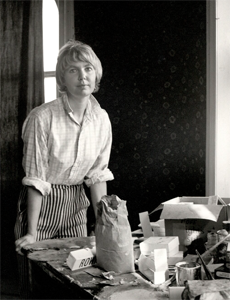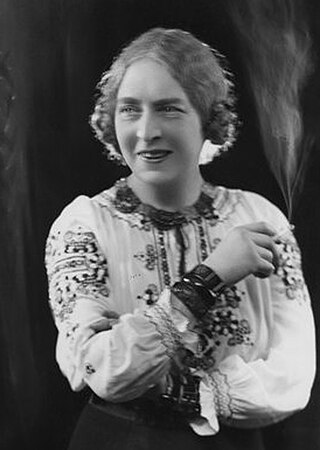Related Research Articles

Bridget Louise Riley is an English painter known for her op art paintings. She lives and works in London, Cornwall and the Vaucluse in France.

Gillian Ayres was an English painter. She is best known for abstract painting and printmaking using vibrant colours, which earned her a Turner Prize nomination.
Jean Rees (1914–2004) was a British artist.

Sandra Betty Blow was an English abstract painter and one of the pioneers of the British abstract movement of the 1950s. Blow's works are characteristically large scale, colourful abstract collages made from discarded materials.

Edward Bird was an English genre painter who spent most of his working life in Bristol, where the Bristol School of artists formed around him. He enjoyed a few years of popularity in London, where he challenged the dominance of Sir David Wilkie in the genre painting field, before moving on to history painting, specialising in battle scenes.

Dame Elizabeth Violet Blackadder, Mrs Houston, was a Scottish painter and printmaker. She was the first woman to be elected to both the Royal Scottish Academy and the Royal Academy of Arts.
George Peter Lanyon was a British painter of landscapes leaning heavily towards abstraction. Lanyon was one of the most important artists to emerge in post-war Britain. Despite his early death at the age of forty-six he achieved a body of work that is amongst the most original and important reappraisals of modernism in painting to be found anywhere. Combining abstract values with radical ideas about landscape and the figure, Lanyon navigated a course from Constructivism through Abstract Expressionism to a style close to Pop. He also made constructions, pottery and collage.

Dame Laura Knight was an English artist who worked in oils, watercolours, etching, engraving and drypoint. Knight was a painter in the figurative, realist tradition, who embraced English Impressionism. In her long career, Knight was among the most successful and popular painters in Britain. Her success in the male-dominated British art establishment paved the way for greater status and recognition for female artists.

Joan Kathleen Harding Eardley was a British artist noted for her portraiture of street children in Glasgow and for her landscapes of the fishing village of Catterline and surroundings on the North-East coast of Scotland. One of Scotland's most enduringly popular artists, her career was cut short by breast cancer. Her artistic career had three distinct phases. The first was from 1940 when she enrolled at the Glasgow School of Art through to 1949 when she had a successful exhibition of paintings created while travelling in Italy. From 1950 to 1957, Eardley's work focused on the city of Glasgow and in particular the slum area of Townhead. In the late 1950s, while still living in Glasgow, she spent much time in Catterline before moving there permanently in 1961. During the last years of her life, seascapes and landscapes painted in and around Catterline dominated her output.
Victor Arthur James Willing was a British painter, noted for his original nude studies. He was a friend and colleague of many notable artists, including Elisabeth Frink, Michael Andrews and Francis Bacon. He was married to Portuguese feminist artist Paula Rego.

Gladys Maccabe, MBE HRUAFRSA MA(Hons)ROI was a Northern Irish artist, journalist and founder of The Ulster Society of Women Artists.
Gillian Mary Wise was a British artist devoted to the application of concepts of rationality and aesthetic order to abstract paintings and reliefs. Between 1972 and 1990 she was known as Gillian Wise Ciobotaru.
Rosemary "Ray" Howard-Jones was a prolific Welsh painter best known for her impressionistic seascapes and paintings of the coastline of Wales, particularly of the areas around Skomer and Marloes.
Victoria Elizabeth Crowe is a Scottish artist known for her portrait and landscape paintings. She has works in several collections including the National Galleries of Scotland, the National Portrait Gallery, London, and the Royal Scottish Academy.
Kathleen Mabel Bridle ARUA was a British artist and teacher. She influenced Northern Irish artists such as William Scott and T.P. Flanagan.
Jean Manson Clark née Wymer was a British artist known for her depictions of townscapes, landscapes, for her flower paintings and murals.

Felicity Ursula Hartland Charlton was a British artist known for combining realism and fantasy elements in her paintings often of figures in gardens. Although born in Bristol, Charlton spent the majority of her life working in Wales.
Jane Carpanini is a British artist and teacher, known for her watercolour paintings.

Mary Spencer Watson was an English sculptor. Watson was born in London and spent most of her life in Dorset and was inspired by watching masons carving Purbeck stone, close to her family home there. Her works can be seen at Cambridge University and Wells Cathedrals, among other sites.
Moira Gay Huntly is a British artist and author, known for her paintings of landscapes, buildings and maritime subjects
References
- 1 2 3 Frances Spalding (1990). 20th Century Painters and Sculptors. Antique Collectors' Club. ISBN 1 85149 106 6.
- 1 2 3 "Peter Teed, headmaster, and Shirley Teed, artist". The Yorkshire Post. 1 September 2018. Retrieved 17 March 2019.
- 1 2 3 4 David Buckman (2006). Artists in Britain Since 1945 Vol 2, M to Z. Art Dictionaries Ltd. ISBN 0 953260 95 X.
- 1 2 "Shirley Teed's retrospective celebrates a mother's love in oils at School House Gallery". The Press (York). 21 August 2018. Retrieved 18 March 2019.